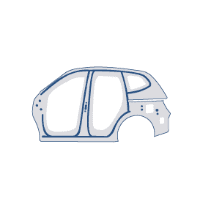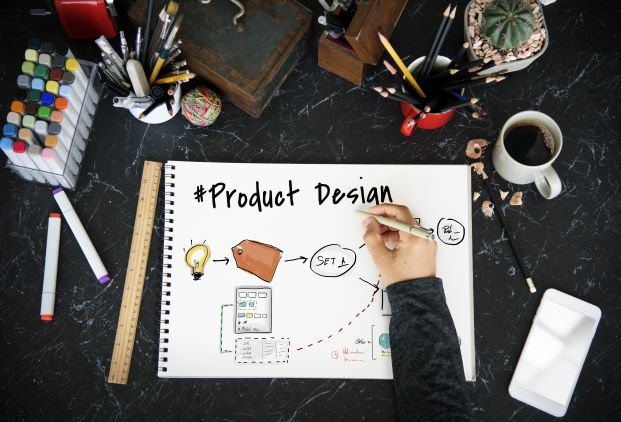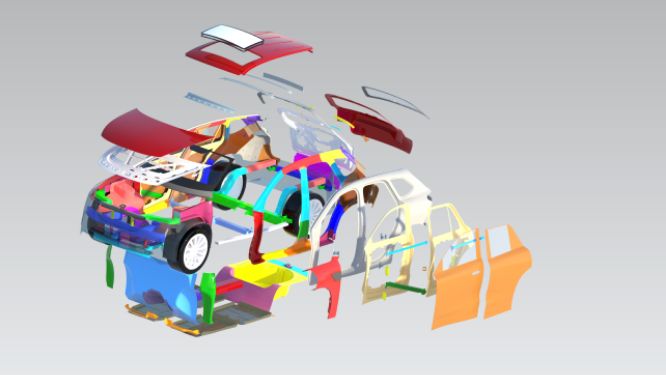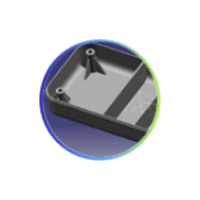Courses by Software
Courses by Semester
Courses by Domain
Tool-focused Courses
Machine learning
POPULAR COURSES
Success Stories
Boeing-747 _ Final_Project
MODELLING BOEING 747-8 USING SOLIDWORKS OBJECTIVE Understanding of SolidWorks by modelling and assembling the Boeing 747-8 aircraft. INTRODUCTION Boeing 747-8 is a wide-body aircraft being the largest variant of the 747 is modelled using the SolidWorks a CAD and CAE program. The below data shows the specifications…
Cynthia Sharon Lawrence
updated on 31 Aug 2020
MODELLING BOEING 747-8 USING SOLIDWORKS
OBJECTIVE
Understanding of SolidWorks by modelling and assembling the Boeing 747-8 aircraft.
INTRODUCTION
Boeing 747-8 is a wide-body aircraft being the largest variant of the 747 is modelled using the SolidWorks a CAD and CAE program. The below data shows the specifications of the aircraft used for designing.
- Seats (3-class) - 410
- Range - 7,730 nautical miles (14,310 km)
- Length - 3 m (250 ft 2 in)
- Wingspan - 4 m (224 ft 5 in)
- Height (overall) - 4 m (63 ft 6 in)
- Height (nose to ground) - 8 m (19 ft 02 in)
- Engine - GEnx-2B
DESIGN METHODOLOGY & DESCRIPTION
- Blueprint
- Fuselage
- Belly Fairing
- Nose Cone
- Pitot Tubes
- Cockpit Windows
- Windshield Wipers
- Passenger Windows
- Doors & Hatches
- Lights & Antennas
- Auxiliary Power Unit
- Vertical Stabilizer & Horizontal Stabilizer
- Wing, Flaps & Ailerons
- Flap Track fairings
- Landing Gear Axis, Hatches Closed & Hatches Opened
- Wheels
- Nose Gear Base, Suspension Arm & Assembly
- Main Gear Base, Suspension Arm & Assembly
- Engine
- Livery
- Assembly
I. BLUEPRINT
The blueprint pictures are inserted to sketch over. They are also used as a reference for modelling. Figure 1.1 shows the blueprint setup for the Boeing 747-8

Figure 1.1 Blueprints
II. FUSELAGE
The fuselage is the main body section of the aircraft. It holds the crew, passengers, and cargo.
Tools & features used: Surface Loft, Mirror, Thicken, Convert Entities, Fillet & Reference planes
Lines and splines with horizontal, vertical and tangent relations are used to draw the sketch. Multiple sketches are used to maintain the overall shape of the fuselage. Eleven reference planes are created to loft. The surface loft is used to create the body requiring the upper outline sketch, lower outline sketch and mid outline sketch. After completing the surface it is mirrored and thickened into a solid. Figure 1.2 shows the final lofted body of the fuselage.

Figure 1.2 Fuselage
III. BELLY FAIRING
Also known as ventral fairing is located under the fuselage between the main wings and covers the landing gears and holds additional cargo.
Tools & features used: Extrude Boss/Base, Split, Mirror, Fillet & Combine
The belly fairing is sketched and boss extruded for a distance of 3080 mm. Extruded body is then split, filleted and mirrored. The created belly fairing is then combined with the fuselage making them a single solid body. Figure 1.3 shows the belly fairing created.

Figure 1.3 Belly Fairing
IV. Nose Cone
Nose cone reduces the drag of the aircraft and houses the radar and other instruments
Tools & features used: Split Line, Sweep Boss/Base & Mirror
Three vertical lines are sketched and split lined into eight individual faces. Then the sweep boss/base command is used with a value of 20mm. The created nose is then mirrored to the right plane resulting as in Figure1.4

Figure 1.4 Nose Cone
V. Pitot Tubes
This measures the fluid flow velocity and determines the airspeed of an aircraft.
Tools & features used: Extrude boss/base, Reference Axis, Chamfer, Sweep boss/base, Convert Entities, Extrude cut & Mirror.
Pitot tubes are sketched with lines and splines and a line in the front plane is sketched with an angle of 40° along which, the direction of the extrude boss/base is done with a blind value of 150 mm. A reference axis is introduced along which it swept for a value of 25mm. It is then chamfered and filleted. The front face of the pitot tubes are then cut extruded for about 150 mm which then is mirrored about the right plane. Figure 1.5 & Figure 1.6 are the final outcome of the designed pitot tubes.

Figure 1.5 Pitot Tubes

Figure 1.6
VI. Cockpit Windows
The cockpit window weighs 68 kilogram with a thickness of 76mm. It has the electric defroster to get rid of fog or ice on wind shield.
Tools & features used: Mirror, Split Line, Offset Entities, Offset Surface, Thicken & Fillet
Using the midpoint line, spline and 3 point arc the overall sketch of the cockpit windows are drawn. It is then spilt lined to project the sketch on to the surface. Using the offset entities command it is offset for a distance of 45mm in the reverse direction. It is again offset for a value of 0mm which is a copy surface and thickened for 5m to fill the gaps. Figure 1.7 shows the designed cockpit windows.

Figure 1.7 Cockpit Windows
VII. Windshield Wipers
These wipers work independently giving the pilot and co-pilot control over his/her wind shield
Tools & features used: Extrude boss/base, Project curve, Sweep boss/base, Shell, 3D sketch, Move/Copy and Fillet
The body is shelled about 50 mm before starting the sketch because in further modelling it becomes difficult to shell the body cause certain thicken values will be greater. A line of length 1000 mm and height 200 mm is created from the cockpit windows to be used as an extrude direction (Fig 1.8) .

Figure 1.8 Extrude direction
A circle of diameter of 75 is extruded to a distance of 20 mm along the extrude direction (Fig 1.8) and the antennas are created (Fig 1.9).

Figure 1.9 Antenna
Water sprayer (Fig 1.10) is created by extruding an ellipse of width 15mm for about 80 mm along the extrude direction mentioned above (Fig 1.8).

Figure 1.10 Water Sprayer
The wiper arm is sketched and project curve is used to project sketched curve onto the face. It is then swept boss/base for 35mm and filleted for 10mm Wiper barer is sketched by creating a slot at 39˚ from the centre line of the fuselage at a length of 180 mm and width 110 mm. A 3D sketch of spline of length 445 mm is sketched on the wiper bearer and swept for 20 mm ( Figure 1.11) . Figure 1.12 shows the entire setup of wipers, antennas and water sprayer. Move/Copy is used to move the wiper body up off the fuselage with a distance in y-direction of 15 mm.

Figure 1.11 Wiper

Figure 1.12 Windshield Wipers
VIII. Passenger Windows
The outer pane of the window is 12 mm thick while the inner pane is 4 mm. It is separated by a 6mm air chamber and the total thickness is 22 mm.
Tools & features used: Block, Split line & Linear pattern
The window is created in the form of a block and inserted into the model
How to create a block? : New part > Sketch > Tools > Blocks > Make > Select sketch > Save
The created block is inserted into the sketch according to the blue print. It is offset for 20 mm. It is then linear patterned for distance of 507.7 mm and 63 as the number of instances . Instances to skip are selected to remove the blocks from unrequired positions. It is again linear pattern for 33 instances at a distance 507.9 mm. The blocks are then projected with split line command (Fig 1.13).

Figure 1.13 Passenger Windows
IX. Doors & Hatches
The door is designed to seal itself by taking advantage of pressure difference on its two sides and is used on the aircraft with cabin pressurization.
Tools & features used: Block, Trim, Linear Pattern, surface offset, Thicken & Split line
The door is 1000 mm wide and 1900 in height. It is offset for 50 mm and made in to a block. Then it is split lined to project the block (Fig 1.14). It is then linear patterned and there are a total of 12 doors. Similarly the hatches and cockpit windows are created (Fig 1.15) (Fig 1.16).

Figure 1.14 Door

Figure 1.15 Hatches

Figure 1.16 Cockpit Door
X. Lights & Antennas
Anti-collision lights (Fig 1.19) are a set of lights required on every aircraft to improve visibility to others.
There are many antennas like ELT, SATCOM, VHF etc mounted on the aircraft for their own purpose.
Tools & features used: Extrude boss/base, Revolved boss/base, Split & Draft Xpert
Sketch of the light is revolved boss/bass-ed for 360˚ along the axis of revolution. A line is drawn at the base of the light and selected as the trim to sketch and revolved light as selected bodies to cut for the split command.
The antennas are sketched and boss extruded for 30 mm and draft xpert is used for 2˚. Figure 1.17 and Figure 1.18 are values to copy the designed antenna to their respective position as in Figure 1.21 and Figure 1.20


Figure 1.17 Figure 1.18

Figure 1.19 Lights

Figure 1.20 SATCOM & ELT

Figure 1.21 VHF
XI. Auxiliary Power Unit
APU provides energy for functions other than propulsion.
Tools & features used: Extrude boss/base, Extrude cut & Dome
An exhaust is created for a diameter of 750 and cut extruded for 1500 mm with an offset of 74500 mm. Inner surface of the exhaust is of 650 diameter and boss extruded for 120 mm with an offset of 73000 mm.
The tail support is of dimension 50 mm wide and 500 mm long. It is offset for 0 mm and thickened for 120 mm.
The tail lights are of 110 diameter and extruded for 50 mm and drafted outward for 2˚. It is offset for 8mm and cut extruded for 2 mm. The front surface of the light is made into a 10 mm dome and white LED appearance is applied.

Figure 1.22 Tail Lights & Exhaust
XII. Vertical Stabilizer & Horizontal Stabilizer:
The VS keeps the nose of the aircraft from swinging side to side (yaw) and HS keeps the nose from up-down motion (pitch).
Tools & features used: Extrude boss/base, Cut extrude & Project curve
The vertical and horizontal stabilizers are lofted along the two guide curves. VS is cut extrude with a thin feature of 20 mm for rudder and trim tabs. HS is modelled with projection curve and cut extrude forming the elevators and trim tabs.

Figure 1.23 Vertical Stabilizer

Figure 1.24 Horizontal Stabilizer
XIII. Wings, Flaps & Ailerons
Flap reduces the stalling speed and ailerons aids in controlling lateral balance.
Tools & features used: Cut extrude, reference plane & Split Line
The flaps and ailerons are sketched and cut extruded for 30 mm. A reference plane of 2000 mm from the top plane is created. It is split lined to project the sketch (Fig 1.25, Fig 1.26).

Figure 1.25 Wings

Figure 1.26 Flaps & Ailerons
XIV. Flap Track fairings
It is enclose mechanism for deploying the wing flaps and reduces wave drag.
Tools & features used: Extrude boss/base, Split & Move/copy
FTF are made by boss extruding for 600 mm with an offset distance of 400 mm and te unwanted segments are cut out using split command. After filleting they are body move/copied for 4 instances (Fig 1.27).

Figure 1.27 Flap Tracks
XV. Landing Gear Axis, Hatches Closed & Hatches Opened
Tools & features used: Split line, Surface offset, Thicken, Surface sweep & Mirror
Multiple axis (Fig 1.30) are created to position the landing gears. Landing gear hatches closed (Fig 1.31, Fig 1.32) are projected using split line with an offset of 0 mm and thickened for 20 mm. Open hatches (Fig 1.33, Fig 1.34) are thickened for 40 mm and cut extruded. The sketch profile is surface swept.

Figure 1.30 Axis

Figure 1.31 Nose Hatch Closed

Figure 1.32 Main Hatch Closed

Figure 1.33 Nose Hatch Open

Figure 1.34 Main Hatch Open
XVI. Wheels
Aircraft tyres are too rigid to be forced onto a rim like automotive tyres. The inboard and outboard hubs are bolted together with the tyre in the centre
Tools & features used: Revolved boss/base , Shell& Revolved cut
An axis is created and revolved around it for 360˚. It is revolved cut to form the creases of the tyre and shelled (Fig 1.35). The rim is revolved as well and fit within the tyre and the face of the rim is domed (Fig 1.36).

Figure 1.35 Tyre

Figure 1.36 Rim

Figure 1.37 Wheel
XVII. Nose Gear Base, Suspension Arm & Assembly
Tools & features used: Dome, Cut Extrude, Cis-pattern, boss extrude & Chamfer
The nose gear base, suspension arm (Fig 1.39) and wheel are created as separate part files and assembled. Multiple sketches and features are used for the base model (Fig 1.38). The assembly (Fig 1.40) is made using mates coincident and concentric.

Figure 1.38 Nose gear base

Figure 1.39 Nose Suspension Arm

Figure 1.40 Nose Gear Assembly
XVIII. Main Gear Base, Suspension Arm & Assembly
Tools & features used: Cut Extrude, Cis-pattern, boss extrude & Chamfer
The main gear base (Fig 1.41) is quite complex because of multiple feature and sketches. The suspension arm( fig 1.42) is given with a limit angle of 179.9˚.

Figure 1.41 Main Gear Base

Figure 1.42 Suspension Arm

Figure 1.41 Main Gear Assembly
XIX. Engine
The Boeing 747-8 has the GEnx-2B which is an advanced dual rotor, axial flow, high-bypass turbofan jet engine featuring a smaller fan, de-staged booster and de-staged low-pressure turbine.
Tools & features used: Revolve, Split, Cir-Pattern & Revolve Thin
An engine blueprint is used to sketch the engine and axis is created around which it is revolved for 360˚ and cut extruded. The rotor blades are cir-patterned for 18 instances (Fig 1.42).

Figure 1.42 Engine
XX. Livery
An aircraft livery is a set of comprehensive insignia comprising colours, graphics, and typographical identifiers which operators apply to their aircraft.
Tools & features used: Blocks & Split Line
Blocks are inserted and the appearances are changed according to the requirement

Figure 1.43

Figure 1.44
XXI. Assembly
The sub-assemblies of nose gear and main gear are inserted and using the mates function they are assembled .The sub-assemblies are made to float to add flexibility and finally their flexibilities are synced so the nose gear and main gear move in unison (Fig 1.45)

Figure 1.45 Final Assembly
RENDERED IMAGES

Figure 1.46 Top View

Figure 1.47 Side View

Figure 1.48 Bottom View

Figure 1.49 Rear View

Figure 1.50 Isometric View
CONCLUSION
In this project all major components of Boeing 747-8 was designed using various work benches of SolidWorks.
Leave a comment
Thanks for choosing to leave a comment. Please keep in mind that all the comments are moderated as per our comment policy, and your email will not be published for privacy reasons. Please leave a personal & meaningful conversation.
Other comments...
Be the first to add a comment
Read more Projects by Cynthia Sharon Lawrence (14)
Week 7 Challenge - Assembly Workbench
MODEL 1 MODEL 2
11 Apr 2023 02:07 PM IST
Design of backdoor
OBJECTIVE Use the provided styling surface and come up with a back door design using appropriate design methodologies, and provide necessary reinforcements and embosses. DESIGN The back door of the car is for the enclosed space (boot) to hold the luggage. There are three types of back doors based on their opening. Top-mounted…
29 Aug 2021 06:34 AM IST
Roof challenge
OBJECTIVE To design and develope automotive roof with its components and do draft analysis to check for manufacturability of the part and with the feedback change the model design when needed. ROOF DESIGN 1. Front Roof Rail 2. Rear Roof Rail 3. Bow Roof Rails 4. Center Roof Rail a) Heat distortion…
01 Jun 2021 03:51 PM IST
Section Modulus calculation and optimization
OBJECTIVE: Use the Section from theHood design and calculate the section modulus using the formula S = I/y Section Modulus: The section modulus of the cross-sectional shape is of significant importance in designing. It is a direct measure of the strength of the object. An object that has a larger section…
16 Feb 2021 07:05 PM IST
Related Courses





Skill-Lync offers industry relevant advanced engineering courses for engineering students by partnering with industry experts.
Our Company
4th Floor, BLOCK-B, Velachery - Tambaram Main Rd, Ram Nagar South, Madipakkam, Chennai, Tamil Nadu 600042.
Top Individual Courses
Top PG Programs
Skill-Lync Plus
Trending Blogs
© 2025 Skill-Lync Inc. All Rights Reserved.










